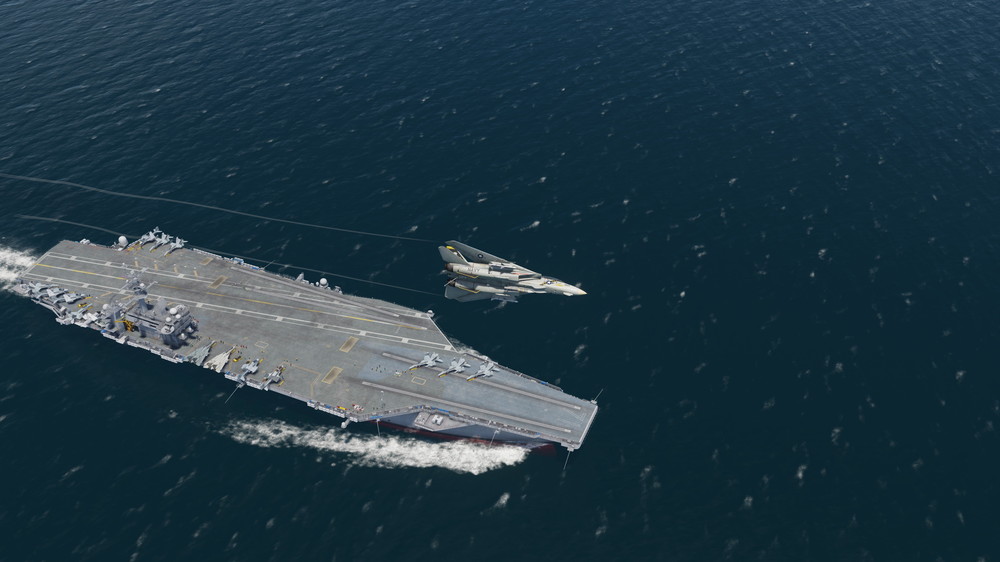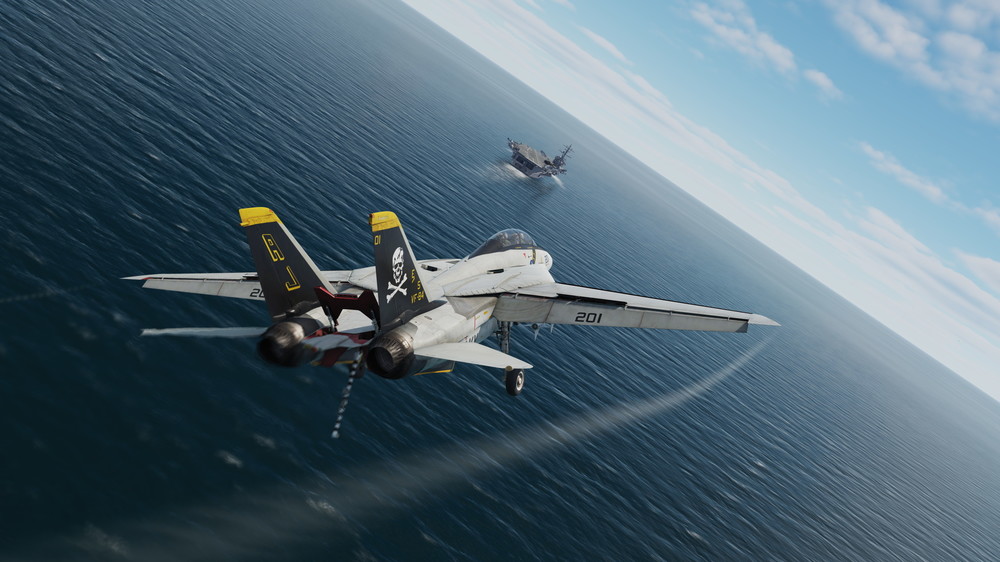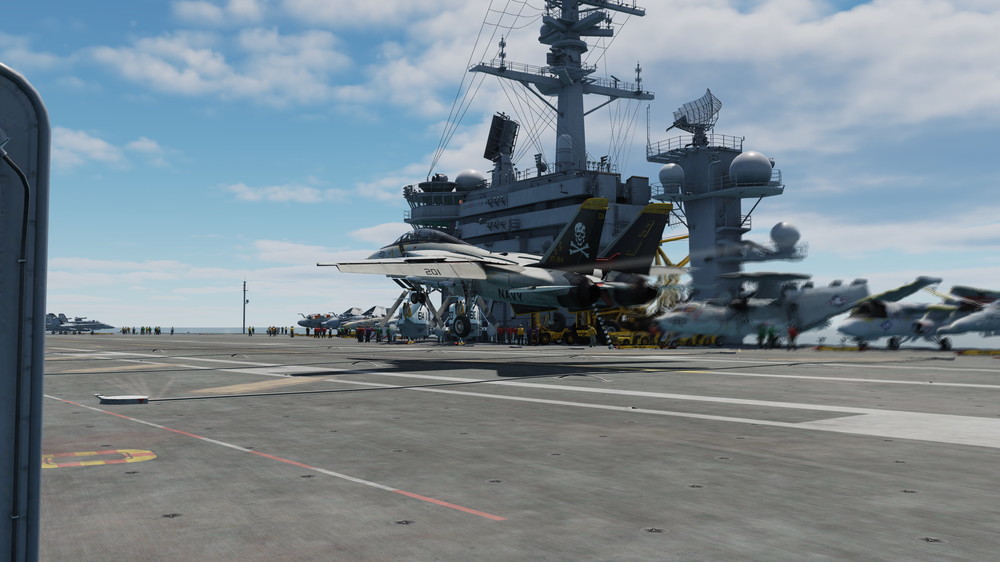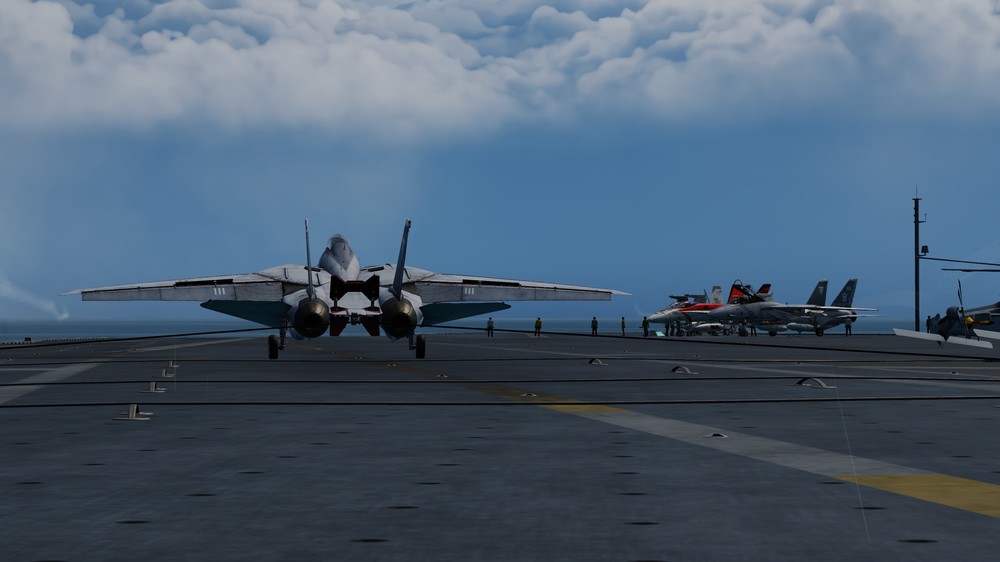-
Posts
984 -
Joined
-
Last visited
Content Type
Profiles
Forums
Events
Posts posted by sLYFa
-
-
directly into the "Navy Equipment" folder, e.g. "C:\Users\user\Saved Games\DCS.openbeta\Mods\tech\NavyEquipment", overwrite the original file
-
 1
1
-
 3
3
-
-
Thank you! It works now!
-
same here, ships completely disappear with this mod installed. Very sad since I've used a lot of its objects on carrier decks

-
Handpump functionality has been implemented a while ago. Emergency flaps have been there from the start (i.e. outboars spoiler module talking over in case of comb pressure loss). If you mean the emergency functions of the flap handle, emer dn has no function while emer up has the same function as normal up but overrides any lockouts (little use in DCS IMO).
The fire bottles supposedly work but I havent tested those. A fix for the AoA brightness thumbwheel would certainly be nice though
-
-
IRL the stick moves when you trim it, so you basically put the stick where you want it and use the trim hat to remove the force which is the opposite of what you do with a spring centered stick, where the stick is moved back to center while trimming. IMO that would already go a long way, not to mention trim release for helicopters. Couldn't care less about any shaking effects though.
-
17 hours ago, Jayhawk1971 said:
I just tried that and made a booboo. I accidentally deleted the original file, and with the changes DCS freezes on loading a mission with the Supercarrier module. Can you, or anyone else, please post the original, none-changed values so that I can change it back?
I suppose the "wing_unfold_condition" value before I changed it to 404 is the crux.
Update:
Got some great help in the customer support section. Got it fixed.
Here's both files, original and modded for F-14A
-
 1
1
-
-
On 2/9/2022 at 9:40 AM, Lurker said:
I believe that there is a bug. Or rather if there isn't I don't understand what the purpose of the 9% from threshold is in the DCS Hind. The Hind recognizes pedal inputs less than 9% from center, if you do small corrections with the YAW AP channel on within that threshold the heading hold function will fight your inputs. This can lead to all sorts of wonky flight issues.
The 9% deflection threshold is a DCS workaround. Whenever your physical pedals are beyond that threshold, the YAW AP recognizes the pedal microswitches as pressed and will go into stabilization mode. This creates a weird situation when you deflect your pedals inside the 9% threshold and your inputs fight the APs inputs, which can not happen IRL unless the pilot moves the pedals without touching the microswitches.
Also note that this applies regardless of whether the pedal trim option is active or not. This basically renders YAW AP useless if you do not use the pedal trim option, since in this case, your physical pedals will almost always be more then 9%off center and heading mode will not engage.
-
The ITS (integrated trim system) will automatically apply NU trim with flap deployment to counter the flap-induced pitch down moment. It should also apply ND trim with speedbrake deployment, although this is not implemented, since in DCS (unlike IRL), the speedbrake doesnt produce the pitch up moment that would require a trim change. There is also a mach trim feature which increases NU trim ass you go supersonic. All these "autotrim" features are rather primitive though and not remotely comparable to actual autotrim of FBW planes, so you still have to trim manually a lot.
-
 1
1
-
-
Not modelled but would be nice to have!
-
5 hours ago, Stratos said:
Nice find, wondering what he's saying.
At 4:45 he says: Ground target detected at three o'clock, 100m, truck.
-
 2
2
-
 1
1
-
-
Well they do give you sensible commence times during case III to deconflict you properly with AI aircraft. I had a nice caseIII recovery with me in between AIs and we all had proper spacing (that obviosly only works if you make your commence time) . The needles call was always accurate for me (e.g. if I was too far of center my pilot would make the according call), just as the FB and distance calls.
I'm not sure what people expect from CATC. Its not there to hold your hand during c3. It does what its supposed to: (simple) deconfliction with traffic and landing information. Proper bolter comms with approach telling you when to turn final is missing though, hope that gets added sometime since its crucial (and not easy to model) to case3 ops.
-
Do russians even have LSOs? Russian carrier ops is such a mystery, there are zero docs on that (at least none I know of).
-
It does, TWS auto only uses the tracks visible in the current TID range.
-
 2
2
-
-
It would be nice to have a launch/recovery editor where we can define where aircraft are parked before launch, the launch order, where aircraft go after recovery and set launch/recovery time windows.
All this is already possible with some lua editing and ME magic but a dedicated tool for that in the ME would be gold IMO.
-
 1
1
-
-
Thats strange, Marshall always tells me to hold on FB reciprocal not BRC. Unless its case II , then BRC is used. FWIW in real life the holding radials are always offset from the FB/BRC by 10-20°
-
-
The VDI and HSD will always show AHRS heading, unless there is some setting to feed them INS TH I don't know of
-
vC is the difference between AHRS supplied magnetic heading (which can be off) and INS true heading.
-
screw the ALR-45, I want my oxygen quantity indicator

-
1) For the AHRS to sync to the magnetic heading, you need to be in level and unaccelerated flight. If you are maneuvering, the sync wont happen
2) That should not happen, however, I experienced the AHRS syncing to some wrong magnetic heading when doing steady turns. I suspect this is a bug but its hard to reproduce
3) Not bad at all. All the navigation calculations are done with INS provided true headings, the AHRS heading (which drives the BDHI and pilot heading tapes) is not used at all for navigation. TACAN radial indication should not be affected either since its does not rely on any heading reference. It does (wrongly) get affected by AHRS heading in DCS though (both BDHI needle and radial indicator)
4) DG (directional gyro) provides a reference to whatever it considers north. If you are in DG mode, you have to manually press and turn the HDG knob until the heading tape/BDHI shows the correct heading (can be either true or mag, depends on what you need). In SYNC, the MAD in the vertical tail provides the reference for the AHRS gyro, i.e. the MAD knows where magnetic north is and tells the AHRS to align its reference to that. This is either done automatically if you are flying level or If you press the HDG knob in SYNC. Note that the latter does not guarantee an alignment of the AHRS to magnetic north, as the limitations on flight attitude remain and acceleration remain.
5) not really an answer but to clarify things. The AHRS directional gyro is what provides heading information to the pilot. The gyro is necessary since using the MAD directly would result in very unstable readouts during maneuvering (much like the whiskey compass). Theoretically, the gyro needs to "know" the direction of magnetic north only once (which it gets from the MAD during startup). But since the MAD-provided reference is wrong on the carrier, the AHRS gyro needs to get the correct reference somehow. This can happen either using the MAD during flight (again, level flight with as little pitch as possible is necessary for that), or manually by selecting DG mode and turning the HDG knob until the BDHI shows the correct heading (which you need to know beforehand, e.g. BRC-90° if you are parked on one of the starboard elevators).
Hope this helps
-
 2
2
-
 1
1
-
-
There are no problems with any control layers or any "concept issues in the code". There is a fundamental difference in how the AP behaves in the Hip and the Hind. In the Mi-8, the AP servos are unaffected by trim while in the Mi-24 they are reset to zero whenever the trim button is pushed. So imagine you are hovering and just found the sweet spot for the cyclic. Before you trim, your total input is your stick position+whatever the AP puts in (which can be up to 20% IIRC). When you press the trim button, the AP input is "taken away" and your total input is not what it was before trimming, even without moving the stick. That's why it is important to trim a lot and thus minimize AP input, especially when transitioning from/to hover.
OPs video showcases that. If you look at the AP indicator in the top right corner, you will see that there is both pitch and roll input from the AP . As the trim button is pressed, AP inputs return to zero, changing the total control input.
Now one can assume that this behavior is exacerbated by the AP inputs being too large in the first place but thats hard to tell without knowing exactly how the AP works (which ED should and we have to rely on them getting it right). There are issues with the FM in general though, most prominently the uncommanded pitch oscillations at approx. 120-150 kph (SAU on or off) and IIRC ED stated that the FM and AP will get revisited during EA. But don't expect the trimming behavior to be the same as in the Hip/Huey.
-
 1
1
-
 2
2
-
-
2 hours ago, fapador said:
On the contrary, YOU have not researched enough before making claims . Look here for inputs by real pilots (even by Eagle Dynamics person who had a go), and control input diagrams (pbishop post page 2) before rushing to engage in "full dcs defend mode" even by questioning multiple videos. Its Crystal clear ZERO Sideslip Right pedal need. Crabbing has nothing to do with it.
You redditesque salt-mine attitude is not appreciated. I never claimed there is nothing wrong with the Huey, just that the inital screenshot OP provided is a text-book example of what the slip ball shows if you want zero crab in forward flight (i.e hanging left to counter translating tendency but thats apparently too much to grasp somehow). The assumption that slip ball and actual aerodynamic slip have to correlate is wrong. You could be flying sideways with a centered ball. The Huey is not a glider, its not as simple as pedal left-> ball right and vice versa.
That itself has nothing to do with the correct amount of right pedal needed for level flight. All these video "proofs" are vague at best. What gross weight are they flying at (affects the amount of collective and pedal need)?, what Huey variant is flown (there are lots of them)? Not to mention the quality. There are just too many unknowns and ED or any serious dev isn't gonna take that as an argument. Actual control curves from the manual are actual evidence OTOH and if you read the post you quoted thats what I asked for. Lets hope they at least acknowledge that issue.
But again this has nothing to do with the slip indicator. Its literally just a ball in a curve. It doesn't care about crab, pedals or anything other then lateral force, which is a result of various forces/control inputs. If you want to showcase actual issues with ball, put the helicopter in situation where you know what the ball has to show. E.g. level flight with zero bank and zero roll/yaw/pitch rates, the ball HAS to be centered in that case. If it doesn't there's a bug. If it does, try more/less crab but keep the bank at zero and make sure you are not turning, the ball still needs to be centered. The amount of pedal required for this doesn't matter for the ball (it does for the FM though of course), no need to overcomplicate things.
-
 2
2
-
-
Claiming something to match or not match "the real" thing based on a few short videos where we don't know which fuel/payload and specific Huey model is flown is not enough I'm afraid. Are there any balancing curves (i.e. what control inputs are needed for level flight at xx KIAS and yy GW) for the Huey? Russian chopper manuals are full of them so maybe there are some for the Huey too.
On 1/13/2022 at 2:41 PM, Tim_Fragmagnet said:The actual issue is that the slip indicator does not properly operate alongside this. As the need for right pedal increases, the leftward motion of the slip indicator increases, almost as if its effects are completely inverted.
So you are basically saying that translating tendency is reversed as in more right pedal requires more bank? Maybe look for the bank angle in stationary, no crab flight at various speeds to confirm that.






TF-30 sub-variants for future F-14 variants?
in DCS: F-14A & B
Posted · Edited by sLYFa
IIRC there was a considerable engine performance downgrade early in the F-14's service life (around 74-75?) after several instances of compressor blades going through the wing box. After that no real changes performance wise though.